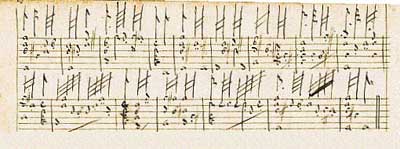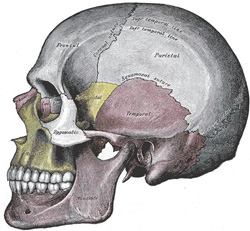February 21st, 2006

“Until the 19th century, there was no concerted effort to standardize musical pitch and the levels across Europe varied widely. Even within one church, the pitch used could vary over time because of the way organs were tuned. Generally, the end of an organ pipe would be hammered inwards to a cone, or flared outwards to raise or lower the pitch. When the pipe ends became frayed by this constant process, they were all trimmed down, thus raising the overall pitch of the organ.”
From the
Wikipedia article on concert pitch – concert pitch has risen over the period of the 19th century to the standardization on the A above middle C being 440Hz in 1955. The main effect has been to increase the demands on singers (more energy at higher notes). The maths in music leads naturally to geometric series and roots and surds….
Posted in Maths | Comments Off
February 19th, 2006
I have re-arranged the way bodmas.org works, and this wordpress blog is back in the bodmas.org/blog subdirectory. I decided I wanted a static page upfront to allow for a wider range of non-blog content arriving over the summer.
All I have to do now is work out how to customise the 404 error messages incase my readers (all 5 of them) follow search engine tags that will now be broken.
Posted in Notes | Comments Off
February 18th, 2006

Bartleby provides searchable access to a range of older and off-copyright reference sources including the 1918 edition of Gray’s anatomy. Nice source of period clip art for PowerPoints, and nice drawings for handouts. Thumbnails lead to larger images, usually 500 to 700 pixels wide, in pastel shading for (e.g.) veins and arteries.
There is a range of more recent material but mainly US-centric. The World Factbook is the 2003 edition, and the entries can be listed by field (e.g. unemployment rate) as well as by country. You can get a list of approximate unemployment rates or a list of the median age of the population for each of the several hundred countries available.
Posted in Notes | Comments Off
February 17th, 2006
Writing is something most teachers have to do, quickly, without much time to revise or reflect. The old journalists’ joke springs to mind: “You can have 3,000 words by lunchtime, 300 words tomorrow but if you need 30 words, I’ll need a week”. The checklists and suggestions below may help (I’m using them when I remember)...
I’m working my way up to a bit of a rant on PowerPoint….
Posted in Notes | Comments Off
February 17th, 2006
The latest results from the F2 breeding experiments with fruit flies below from Lisa C and her students. The students decided to track gender as well as the wing type (sexing flies is hard work apparently)...
| Obs | Wt | Vg | Total |
| M | 62 | 36 | 98 |
| F | 57 | 27 | 84 |
| Total | 119 | 63 | 182 |
Analysis later on…
Posted in Maths | Comments Off
February 16th, 2006
“Sometimes I wish there were no such thing as binary code, and that programs were written and sold in source form in the same way magazine articles, short stories, nonfiction books, and novels are sold: by being offered to publishers. Human readability would be as important as machine parsability. Code would be copyrighted, but never patented. All of it would be documented; that would be half the point.”
Edward Kiser on the c2 wiki page writing programs is writing. Perhaps someone should tell them about Maths….
Posted in Notes | Comments Off
February 15th, 2006
From the Wikipedia article on Flow (psychology), the list below seems to describe some of what is happening in one of those really good lessons.
As Csikszentmihalyi sees it, there are components of an experience of flow that can be specifically enumerated; he presents eight:
- Clear goals (expectations and rules are discernable).
- Concentrating and focusing, a high degree of concentration on a limited field of attention (a person engaged in the activity will have the opportunity to focus and to delve deeply into it).
- A loss of the feeling of self-consciousness, the merging of action and awareness.
- Distorted sense of time – our subjective experience of time is altered.
- Direct and immediate feedback (successes and failures in the course of the activity are apparent, so that behavior can be adjusted as needed).
- Balance between ability level and challenge (the activity is not too easy or too difficult).
- A sense of personal control over the situation or activity.
- The activity is intrinsically rewarding, so there is an effortlessness of action.
- Not all of these components are needed for flow to be experienced.
I can’t resist linking to a
C2 article on
working conditions that might help professional staff – in this case programmers – reach a flow state easily. Food for thought about teachers staff rooms?
Posted in Notes | Comments Off

